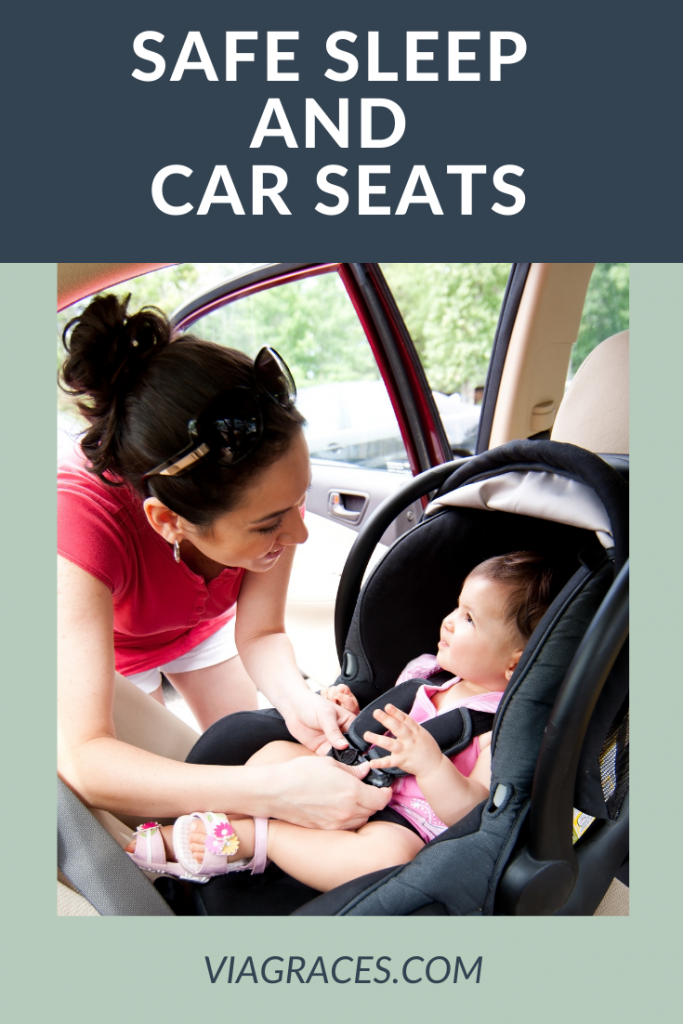The “car nap” – some parents love it as it provides momentary reprieve for a moment of silence, others dread it as it has the potential to disrupt an entire day of a good sleep routine.
Whether your baby falling asleep while on a drive is a matter of going with the flow or stresses you out, let’s go over safe car seat habits for when your little one falls asleep in the car seat.

Young mother putting her baby boy on a safety child car seat.
Car seats are the safest place for your little one while in a moving vehicle – awake or asleep.
The American Academy of Pediatrics makes it very clear that a car seat is the safest place for a baby while in a moving vehicle. If your baby is sleeping in a properly installed car seat, you can rest assured that your baby is safe for errands around the town or a road trip. Proper installation includes both chest clip and crutch buckles clipped at all times!
If you’re unsure how to properly install your child’s car seat, seek help so you can be confident your little one’s safe! You can find an inspection location near you at this link.
Two hours is the maximum amount of time your child should be restrained in a car seat.
For times when your child is in the car seat for an extended period of time, such as a road trip, the rule of thumb is to not exceed 2 hours restrained in a car seat.
Another time you may need to be cognizant of this time limit is if your infant falls asleep while running errands. Infant carriers are portable and often have a convenient stroller system which allows you to simply transfer the car seat from vehicle to stroller. This allows baby to continue to sleep and parents to continue shopping in peace. But remember the two hour limit in these cases!
Also note that your baby should always be fully buckled in the car seat, even if you’re simply walking with it attached to the stroller system.
Your child should be transferred to a safe sleep environment as soon as possible when not in the vehicle.
If you are arriving home and your child is asleep in the car seat, either decide to drive around a bit longer to extend the nap, or make the transfer when you get home.
While it can be tempting to place the car seat in a quiet corner of the house to let them sleep a little longer, it is so important to get in the habit of making the transfer, even if that means a short nap is the result.
On days when parents have energy, parents can reason why it is safer to make the transfer. But as soon as a parent becomes overly tired (often, right?!), they will resort back to what is easiest and most convenient which is often keeping the child in the car even though it’s out of the car.
Car seats are designed to keep babies safe when installed properly, however a baby’s positioning changes when the car seat is on the ground, or on a restaurant booth, and that positioning can restrict airflow. For this reason, get in the habit and the mindset that you MUST take your baby out of the car seat once you’re inside, even if that means a nap ends.
GERD is not a reason for keeping baby in the car seat – asleep or awake.
Parents are often told that if their child has GERD (Gastroesophageal Reflux Disorder) or reflux, that they should elevate their child’s head, or hold them upright, after feedings. Parents will sometimes use their car seat for this purpose as car seats provide an incline which helps achieve head elevation.
When it comes to safe sleep and GERD, the American Academy of Pediatrics has stated that the risk of SIDS outweighs the benefits of prone or lateral lying positions; therefore, supine (flat on their back) is still the safest way for your baby to sleep.* Therefore avoid using the car seat to achieve an elevated head incline as your child could fall asleep and would therefore be in an unsafe sleeping environment.
How to help our babies and children sleep is such an important topic for parents, and safe sleep must be a priority, including how safe sleep can be implemented with car seat use. Learning about the safety measures is key to creating a safe and healthy sleep environment, from the crib to the car!
Thank you for taking the time to read these tips!
ABOUT THE AUTHOR

Meet Rachel Danneman of the Car Seat Clinic! Rachel is a pediatric registered nurse by trade where she practices her passion of caring for children and their families. It wasn’t until she had her own children when she came to understand the confusion around proper use of one of the biggest safety products we invest in for our children – car seats. After discovering there was a lack of professional resources to turn to in the Richmond area, Rachel decided to become the expert she needed and became a Nationally Certified Child Passenger Safety Technician. Car Seat Clinic was founded to help parents attain peace of mind from the very first ride in the car as a newborn, all the way through their growth and development to using the adult vehicle seat belt.
*Task Force On Sudden Infant Death Syndrome. “SIDS and Other Sleep-Related Infant Deaths: Updated 2016 Recommendations for a Safe Infant Sleeping Environment.” American Academy of Pediatrics, American Academy of Pediatrics, 1 Nov. 2016, pediatrics.aappublications.org/content/138/5/e20162938.
